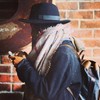Photos via Zahra Siddiqui
Advertisement
Zahra Siddiqui: This mixed media body of work started because of feeling stuck as a photographer. I'm a street photographer and during the winter it can be difficult to create due to the elements. People just don't want to shoot when it's cold, which is understandable but then it puts the street photographer in a creative rut. I turned to collaging National Geographic magazines to pass the time and not let my creativity die. This was the first time I had ever done any type of collaging. After some time I started to play with my own images to create collages. When Elle Alconcel (Daniels Spectrum Curator) approached me to do my first solo show, we had agreed to showcase my photography. She wasn't aware that I was doing mixed media. After sorting through images to print for the show, I would continue collaging and through this birthed the idea to do the entire show using mixed media. I told Elle about my idea and she supported me 100%, even while knowing that I had not done this before on such a large scale. I had never held a paintbrush in my life, never walked into an art store before….didn't even know what some of the materials I needed were called. The experienced forced me to be creative, to learn on my own and to self-motivate.
Advertisement
I wasn't eating. I wasn't bathing. I wasn't sleeping. We are talking 14-hour days. Sometimes I would start projects and then tear them up because they didn't look the way I wanted them to. This was all out of pocket and I really had to hustle and get all the materials I needed. On days I had no money I would just stare and stare at the work, just consumed by it and changing whatever needed to be changed. And then when I could buy materials I would leave the house and just be running around. It was insane. For me the whole thing was emotionally exhausting but also very therapeutic. All the things happening in the world against people of colour, inspired the urge to make this project something that showed beauty and love. This is a timestamp for my community.
People have cried. I didn't expect that. God, I didn't know what I expected. I've had people coming up to me to thank me for showcasing the exhibit. It has just been so incredible and nothing but love and appreciation. Like it is so much bigger than me. This is about my community. The people I spend time with. The elders I listen to. This is for us.
Advertisement
I chose the name The Invisible Majority because it's how I've always seen and described the environments I took space in. I'd always see an abundance of artists and people of colour hidden in little pockets and corners of the city. Every time I would experience these moments I would always be amazed by how many of us there are and how quickly we can disappear and be forgotten when we leave each other, to go face the world.The purpose of this grid (pictured above) was to make an impact, specifically on the artists like myself who can often feel alone but needed a reminder that they're not. Seeing us together was my way of creating such an impact.What does it mean to you knowing that there are non-POC who use racialized bodies as inspiration, make mad money of them, and yet are also racist?
I don't know any white artists in Toronto. I am completely, intentionally and heavily surrounded by melanin. But I appreciate and I am grateful for the fact that I have had to go through the struggle and the hustle because I am a woman and because I am a person of colour. That has made me so much more resilient. White people do not know what that is like and although it bothers me to see them receive praise and see people of colour ignored I try not to think about it and just focus on my art. It's about the art.
Oh yes for sure. Every picture I take I always make sure to ask for permission because so many people (especially men) don't do that. I think that's so disrespectful. So I try to add an element of trust because I am asking these people to invade their space. For me to be able to capture these moments, I need them to be able to trust me and also to be vulnerable. As a woman in this industry there is a vulnerability I have because there aren't that many of us and I am viewed and treated a lot differently than my male counterparts. I still have strong male support surrounding me but I am aware that there is a certain vulnerability that comes with being who I am and also in being a street photographer.What do you want people to take away from your exhibit?
I want people of colour to know that they are loved and they are beautiful and they are seen. Someone came to the opening and asked me why there were no pictures of white people. And I said because you are everywhere. You are everywhere, and this space right now is about and for people of colour. I mean even in "multicultural" Canada people of colour are still going through all the racism and the pain. We are going through difficult times and Canada has perfected the skill of polite racism. This exhibit was my small of way of showing my heart and telling my community they are loved.The Invisible Majority will be on display until the end of October, after which it will be shown in New York.
